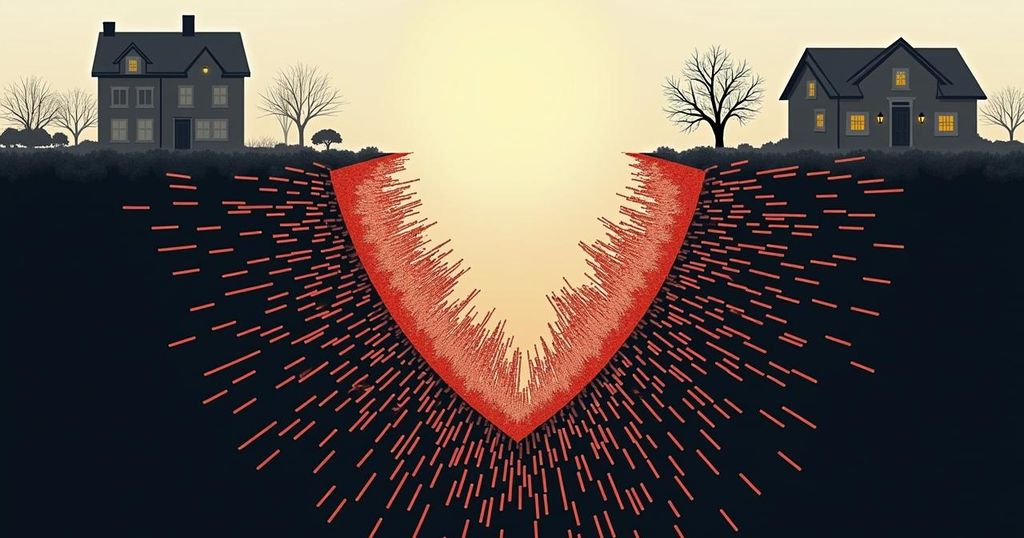A significant earthquake of magnitude 4.8 struck Tewksbury, New Jersey, on April 5, 2024, surprising residents along the U.S. East Coast. Researchers investigated why strong shaking was felt at considerable distances, particularly in New York City, while damage near the epicenter appeared minimal. The study suggests that the earthquake’s rupture direction likely redirected strong ground shaking toward the northeast. Findings may contribute to understanding seismic hazards in the eastern United States and require continued monitoring for further risks.
On April 5, 2024, a magnitude 4.8 earthquake in Tewksbury, New Jersey, astonished East Coast residents, marking the largest instrumentally recorded seismic event in the state since 1900. The incident raised questions about reports of strong ground shaking experienced by individuals in New York City—approximately 40 miles away from the epicenter—while damage reports near Tewksbury were minimal. Researchers YoungHee Kim of Seoul National University and Won-Young Kim of Columbia University investigated these discrepancies, revealing that the earthquake’s rupture direction may have influenced the intensity of felt shaking in different regions. After visiting the epicenter shortly after the event, the researchers noted an unexpected lack of significant property damage. “We expected some property damage—chimneys knocked down, walls cracked or plaster fallen to the ground—but there were no obvious signs of property damage,” they conveyed. Despite this, over 180,000 felt reports were logged—an unprecedented number for a single earthquake on the USGS’s “Did You Feel It?” platform. The quake was reportedly felt by around 42 million people across a stretch from Virginia to Maine, where individuals south of the epicenter reported weak tremors, and those northeast experienced light to moderate shaking. Kim and her colleagues aimed to examine the earthquake’s rupture through models based on seismic wave behavior, revealing that the rupture potentially propagated toward the east-northeast, directing the strongest shaking away from Tewksbury and toward the northeast. Unlike typical earthquakes in the northeastern United States, which mainly occur along existing north-south trending faults, the Tewksbury earthquake likely involved a combination of thrust and strike-slip faulting, as inferred from aftershock locations. While minor damages such as cracks in drywall and fallen objects were documented, a significant structural issue was noted at Taylor’s Mill in Lebanon, New Jersey, highlighting the need for further investigation of potential fault lines in this region. Research indicates the well-known Ramapo fault system was inactive during this event, suggesting the necessity to reevaluate our understanding of stress distribution and seismic risk in eastern North America. The USGS has deployed new seismometers to study crustal responses and aftershock behaviors in the months following the earthquake, enhancing monitoring capabilities and seismic hazard assessments in the region.
The Tewksbury earthquake serves as a significant case study due to its unexpected intensity and the widespread physiological effects experienced by residents far from the epicenter—usage patterns observed in seismic activity across the eastern United States. The investigation not only focuses on the physical characteristics of the earthquake but also analyzes the reasons behind the variance in felt reports, the minimal local damage, and the implications for seismic hazard preparedness in areas traditionally viewed as low-risk. These findings underscore the importance of ongoing research into new fault lines and the mechanics of earthquake occurrences in regions outside of well-mapped seismic zones.
The findings of the Tewksbury earthquake investigation reveal a complex interaction between earthquake rupture dynamics and ground shaking phenomena. They highlight the need for enhanced monitoring in historically calm regions to better understand the mechanisms that govern seismic activity. As researchers continue to study the patterns of aftershocks and the mechanics of the crust in response to seismic events, there is potential for improved preparedness and risk assessment for future earthquakes across the eastern United States.
Original Source: phys.org






